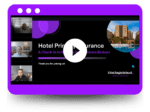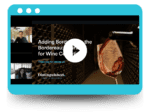There is a reason why your inbox seems perpetually packed: email marketing works. In fact, a study found that for every $1 spent, email has an average $38 return on investment. Even in the age of social media, email marketing continues to outperform other mediums in terms of conversions and lead generation.
Within the insurance industry, the majority of customers prefer emails over other insurance marketing tools, like direct mail and calls. So if you do not practice email marketing, you are missing out on a relatively low-cost way to generate leads and increase sales.
How Do You Create and Build An Email List?
The foundation of an email marketing campaign is a strong email list. With an engaged subscriber list, you will see the highest ROI. There are lots of ways to find people who will be responsive to your emails, but here are a few of the most effective strategies:
- Install a pop-up and create a form for newsletter signups on your website. When people come to your website, they are likely interested in your business and its services. Make it easy for them to stay-in-the-know with website add ons.
- Use a good old-fashioned paper signup sheet. Whether it’s at the front desk or at an event that you are hosting or attending, provide a place for people to sign up and learn more. Whenever you are surrounded by people who are invested in your business, take advantage of it.
- Make your emails captivating and easy to share. With a visually appealing and compelling, people will want to share it with others. Be sure to include information or insights that will be valuable to your target audience.
- Host a contest, offer a discount, provide a free quote, etc — give something away for free in exchange for an email address. Incentivize people to sign up for your email list. The possibilities are endless.
What is Email List Segmentation?
With email marketing, you are able to connect with a variety of clients, both current customers and potential clients, each interested in a specific product or suite of products. Email list segmentation is the process of dividing these subscribers into smaller groups based on specific criteria, such as type of insurance, type of client, or location. Rather than blasting every email to your entire email list, segmentation allows you to send more personalized and relevant emails, resulting in higher conversions.
Choosing an Email Marketing Service
As your list grows, using an excel spreadsheet coupled with Outlook to manage your lists and send emails might not cut it. With so many platforms to choose from, it is challenging to find out which is best for you. Here is an overview of the most popular options:
- MailChimp: MailChimp is one of the most popular and accessible email marketing platforms in the world, with an intuitive interface and adjustable pricing. It integrates with Salesforce, WordPress, Hootsuite, Facebook, Twitter, Pinterest, and Instagram. If you are looking for automated templates and easy designs, MailChimp has it.
- SendinBlue: SendinBlue offers user-friendly email design tools as well as extensive backend development capabilities for those looking to add extra functionality to their campaigns. Their analytics include comprehensive insights, more advanced than most email marketing tools available. Unlocking this platform’s full potential requires a little technical know-how, so it is not for the technology averse.
- GetResponse: GetResponse offers an excellent return on investment, as your price plan is dependent on the size of your company and number of contacts. It is possible to create fully-integrated, interactive campaigns with limited technical knowledge, with their 500 pre-designed templates and intuitive editing and list-building tools.
Ultimately, choosing the best email marketing tool for your needs can be tricky, but with careful research and clear goals, you will make the right choices. Now that we have covered the basics, stay tuned for a separate blog for tips on crafting the perfect email.
Insurance Email Marketing Tips
Whether you are sending a welcome email to a new client or a weekly newsletter to current customers, there are certain things you want to always consider when developing an emailer, such as audience and tone.
- Know Your Audience: Though simple, understanding your audience is the key to a successful insurance email marketing campaign. Every prospect and customer has different needs and interests, and subscribers expect to receive content that is relevant to them. Email list segmentation, as we discussed in an earlier blog, divides your email list into more targeted groups — perhaps by coverage or occupation. Sending out specialized content to each group allows you to promote your products or services in a more personal matter. You will find success by connecting with your subscribers and providing them with useful and relevant content.
- Stay in Touch, Keep It Fresh: While daily or even weekly emails may be counterproductive (not to mention time-consuming), a regular bi-weekly or monthly message can help you stay top of mind with subscribers. Try to vary the type of messages you send out, and refrain from simply sending out only promotions. You can share industry updates, business-related news, blogs, and more. By presenting yourself as helpful and informative, not salesy, people will be more inclined to reach out.
- Short and Sweet: Emails need to be clear and concise. The goal is that subscribers go beyond simply opening the email, to read, and ultimately act on, the message. Keep your emails simple and to the point, don’t go for the verbose hard sale. Avoid having multiple calls to action in one email, as it may leave readers confused and/or annoyed. If they find your email compelling enough, they will pursue it on their own.
- Make it Readable: Just because a subscriber is taking the time to open your email does not mean they want to be met with paragraphs of text. Structure your email so that it breaks content into digestible chunks, with lots of space, subheadings, short paragraphs, and bullet points when applicable. If possible, try using a graphic. And if necessary, use a “read more” link after a brief article to give subscribers the option to learn more.
- Grab Their Attention with the Subject Line: The subject line is the first thing a subscriber will see; it is the deciding factor between trashing or reading an email. Keep subject lines short and to the point. If humor goes with your branding strategy, then use it. If not, imbue it with enough personality to draw in readers while still remaining professional.
Mastering the art of email marketing does not happen overnight. It takes time and consistent effort. At the end of the day, your job is not to create stellar emails, it is to sell insurance. And that’s okay. Focus on authenticity, and keep it simple by taking a step by step approach.





